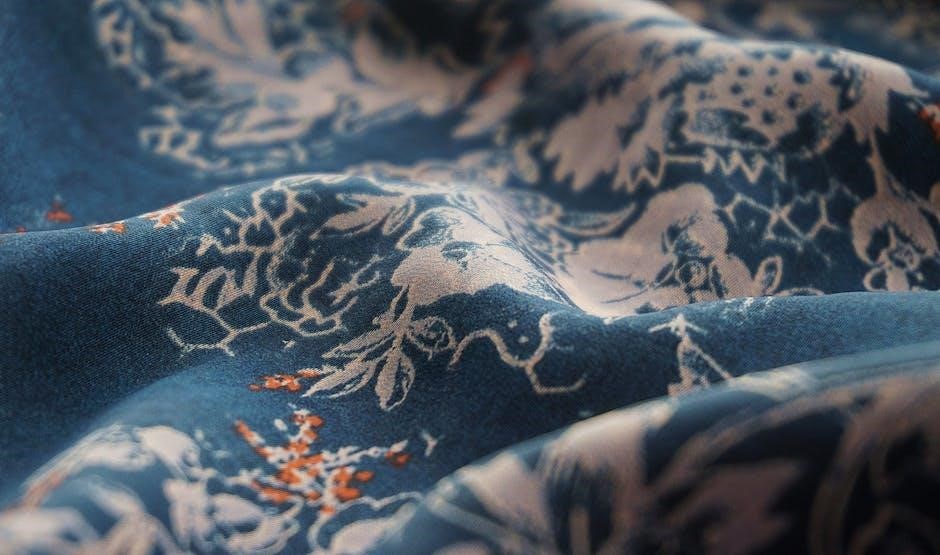Kawandi quilting is a traditional hand-stitching technique from the Siddi people of India, utilizing fabric scraps to create vibrant, layered designs. It emphasizes creativity and sustainability, offering a meditative crafting experience while preserving cultural heritage and promoting eco-friendly practices.
What is Kawandi Quilting?
Kawandi quilting is a traditional Indian craft practiced by the Siddi community. It involves creating vibrant quilts from fabric scraps, primarily using hand-stitching techniques. The process layers small fabric pieces, called tikeli, onto a backing fabric with batting in between. Each piece is secured with simple running stitches. Kawandi quilts are both functional and decorative, celebrating sustainability and creativity. This art form not only preserves cultural heritage but also offers a unique, meditative crafting experience.
History and Cultural Significance
Kawandi quilting originates from the Siddi people of India, descendants of African migrants. This traditional craft reflects their rich cultural heritage and resilience. Passed down through generations, Kawandi quilts symbolize community bonds and resourcefulness, utilizing scrap fabrics to create meaningful pieces. The technique embodies sustainability and creativity, preserving memories and stories through stitching. It is more than a craft; it’s a celebration of identity and tradition, connecting the past with the present.
Benefits of Learning Kawandi Quilting
Learning Kawandi quilting fosters creativity, patience, and mindfulness. It offers a unique way to repurpose fabric scraps, promoting sustainability. This craft enhances fine motor skills and provides a fulfilling hobby. It also connects learners to a rich cultural heritage, offering a sense of accomplishment and pride in handmade creations. Kawandi quilting is a therapeutic activity that encourages self-expression and storytelling through fabric, making it a rewarding pursuit for crafters of all skill levels.

Materials Needed for Kawandi Quilting
Essential materials include assorted fabric scraps, batting, backing fabric, thread, and needles. Optional tools are scissors, rotary cutters, and sewing machines for efficiency and precision.
Fabric Selection and Scrap Usage
Fabric selection for Kawandi quilting involves using small, varied scraps, often from old clothing or leftover materials, to create a vibrant, eclectic design. Traditionally, scraps of cotton, silk, or sari fabric are used, emphasizing sustainability and resourcefulness. Colors and textures are mixed to add visual interest, with no need for matching or coordinating. This approach celebrates diversity and reduces waste, making it an eco-friendly craft. Scraps are organized by size and color to facilitate the layered, appliqué-style construction typical of Kawandi quilts.
Batting and Backing Fabric
In Kawandi quilting, batting is optional but adds thickness and warmth. A thin layer of cotton batting or fabric is placed between the background and appliqué layers. The backing fabric, typically a solid-colored cotton, provides stability and a clean finish; It’s essential to pre-wash and dry both batting and backing to prevent shrinkage. Some quilters opt for a single layer of fabric instead of batting for a lighter, more flexible quilt. The backing is stitched securely to the layers during the quilting process, ensuring a sturdy and durable finish.
Thread and Needle Choices
Choosing the right thread and needle is crucial for Kawandi quilting. Traditionally, a simple cotton thread is used to match the fabric colors, ensuring stitches blend seamlessly. A sharp, thin needle, like a quilting or beading needle, is ideal for hand-stitching through multiple layers. Some quilters prefer silk thread for its strength and luster. The thread color should complement the fabric palette to maintain the quilt’s aesthetic. A thimble is recommended to protect fingers during the stitching process, especially when working with dense layers of fabric and batting.
Additional Tools and Supplies
Besides fabric and thread, essential tools for Kawandi quilting include sharp scissors for precise cutting and a sewing hoop to maintain fabric tension. A rotary cutter and mat can help in accurately trimming scraps. Ironing tools, like a mini iron or travel-sized board, are handy for pressing seams. Storage bins or baskets keep scraps organized, while a needle threader aids in managing fine threads. Optional tools like a sewing machine or quilting gloves enhance efficiency and comfort during the stitching process.

Preparing Your Fabric
Organizing and prepping fabric is crucial for Kawandi quilting. Sort scraps by color, texture, and size, ensuring a cohesive mix. Press fabrics to remove wrinkles, enhancing accuracy when cutting and layering. This step sets the foundation for a smooth, creative stitching process, allowing you to focus on design and technique seamlessly;
Sorting and Organizing Scraps
Sorting and organizing fabric scraps is essential for Kawandi quilting. Begin by categorizing scraps by color, texture, and size to ensure a harmonious mix. Group similar hues together to create a cohesive palette, and separate larger pieces from smaller fragments. This step allows for efficient access during stitching and helps in achieving a balanced design. Organize scraps in a way that inspires creativity, making it easier to layer and arrange them into the unique Kawandi style. Proper organization enhances the overall quilting experience;
Cutting Fabric Pieces
Cutting fabric pieces for Kawandi quilting involves working with small, irregular shapes or scraps. There’s no need for precise measurements, as the charm lies in imperfection. Use scissors or a rotary cutter to cut scraps into varied sizes, focusing on shapes that inspire you. This step encourages creativity and reduces fabric waste. Sort pieces by size and color to prepare for layering. The goal is to create a diverse collection of fragments that will later form the quilt’s unique, textured design. This process is both freeing and meditative, embracing spontaneity and resourcefulness.
Layering Fabric for Kawandi Style
Layering fabric is a cornerstone of Kawandi quilting, beginning with a base layer of background fabric for stability. A piece of batting is then placed on top to add thickness and insulation. Finally, small fabric scraps are arranged in a spontaneous, organic manner, starting from the outer edge and working inward. This method allows for a dynamic, textured design. The layers are secured with stitching, creating a cohesive and visually striking quilt. The process celebrates spontaneity and creativity, resulting in a unique, handcrafted piece that reflects the quilter’s personal style and resourcefulness.

Constructing the Kawandi Quilt
Begin with a background fabric, adding batting for thickness. Sew small fabric scraps on top using long straight stitches, creating a layered, textured design that reflects cultural heritage.
Creating the Background Layer
Start by selecting a base fabric for your quilt, ensuring it is large enough for your design. Cut it to the desired size and layer it with batting of the same dimensions. This foundation provides stability and thickness to your quilt. Traditionally, the background is a single piece of fabric, but modern adaptations allow for pieced backgrounds. Secure the layers together using temporary stitches or pins. This step sets the stage for adding intricate appliqué pieces, creating a canvas for your unique Kawandi design.
Adding Batting and Backing
Place the batting on the background fabric, ensuring it aligns perfectly. Add the backing fabric, creating a sandwich. Use straight pins or temporary stitches to secure the layers. Traditional Kawandi quilts use a thin layer of batting or even another layer of fabric for thickness. This step ensures your quilt has the necessary loft and structure, preparing it for the decorative stitching and appliqué pieces that follow. Proper layering is essential for achieving the desired texture and durability of the quilt.
Appliqué Technique for Fabric Pieces
Each small fabric piece, known as a tikeli, is sewn onto the backing fabric using long straight stitches. This appliqué technique creates a decorative layer, with stitches following the fabric’s edges. The process is meditative and allows for creative freedom in arranging the pieces. Working from the outside in, the tikeli are placed to form a cohesive design. While traditionally done by hand, modern adaptations allow for machine stitching, maintaining the quilt’s unique texture and cultural essence. This step brings the quilt to life, blending functionality with artistic expression.
Assembling the Quilt Top
Assembling the quilt top involves arranging and securing the appliquéd fabric pieces in a layered, spiral pattern. Starting from the center, each piece is placed outward, ensuring alignment and balance. The background fabric serves as the base, with batting added for thickness. Straight stitches or machine quilting secure the layers, creating a spiral effect. This step requires patience and attention to detail to achieve a cohesive, visually appealing design that honors the traditional Kawandi style while allowing for personal creativity and expression.
Quilting Techniques
Kawandi quilting techniques include traditional hand-stitching with straight lines and spiral patterns. Machine adaptations offer efficiency while preserving the cultural essence of this unique, layered fabric art form.
Traditional Hand-Stitching Methods
Traditional Kawandi quilting relies on hand-stitching, where small fabric pieces are sewn onto a backing fabric using a simple running stitch. This method, passed down through generations, emphasizes patience and precision. The stitches are typically straight and evenly spaced, creating a textured, layered appearance. Hand-stitching allows for a meditative process, connecting the creator to the cultural heritage of the Siddi people. It also ensures flexibility, as pieces can be adjusted during the stitching process, making it a forgiving yet rewarding technique for crafters of all skill levels.
Machine Quilting Adaptations
Machine quilting offers a modern twist on traditional Kawandi techniques, allowing for faster creation while maintaining the style’s essence. Tutorials suggest using a machine with straight stitching, following the square shape of the backing fabric. This method skips outlining each piece, instead sewing in straight lines for a clean, textured look. Some quilters use a walking foot for even stitching, while others adapt spiral quilting patterns. Machine quilting makes Kawandi more accessible, enabling larger projects and quicker assembly while staying true to the cultural and artistic roots of this unique quilting style.
Straight Stitching and Spiral Quilting
Straight stitching is a core technique in Kawandi quilting, often done by machine or hand, following the fabric’s natural grain. This method creates a clean, minimalist look. Spiral quilting adds a dynamic, modern twist, with stitches radiating from a central point. Both techniques enhance texture and visual appeal. For machine work, a walking foot ensures even stitching, while spiral patterns offer a creative, flowing design. These methods blend tradition with innovation, allowing quilters to explore Kawandi’s artistic potential while maintaining its cultural essence and unique charm.
Finishing the Quilt
Finishing a Kawandi quilt involves binding the edges neatly, adding a sleeve for hanging, and inspecting for any loose stitches. These final touches ensure durability and a polished appearance.
Binding the Edges
Binding the edges of a Kawandi quilt involves neatly folding and stitching the raw edges to prevent fraying. Use a coordinating fabric strip, folding it over the quilt’s perimeter and securing it with straight stitches. This step not only finishes the quilt but also adds a decorative touch. Ensure the binding is tightly secured to maintain the quilt’s shape and durability. Properly bound edges enhance the overall appearance, making the quilt ready for display or use.
Adding a Sleeve or Hanging Pocket
Adding a sleeve or hanging pocket to your Kawandi quilt allows for easy display on walls or in exhibitions. Cut a fabric strip, fold it into a sleeve, and sew it along the quilt’s top edge. Ensure the sleeve is wide enough for a dowel or rod. For a hanging pocket, attach a small fabric pouch to the back, stitching along three sides to create a secure hold. These additions not only enhance functionality but also preserve the quilt’s beauty while showcasing it with elegance and convenience.
Final Touches and Inspection
Once your Kawandi quilt is complete, inspect it for loose threads or uneven stitching. Trim any excess fabric or batting, ensuring all edges are secure. Check the binding for tightness and the appliqué pieces for stability. Add a personalized label or signature for a finishing touch. Finally, gently hand-wash or spot-clean the quilt to remove any dirt or debris. Allow it to air-dry before displaying or storing. This meticulous inspection ensures your quilt is both durable and visually stunning, ready to be cherished for years to come.

Tips and Tricks
Organize fabric scraps by color and size for efficient use. Use a thimble for hand-stitching comfort and maintain consistent stitch length. Work patiently, embracing imperfections for authenticity.
Working with Scraps Efficiently
Organizing fabric scraps by color, texture, and size simplifies the creative process. Store scraps in labeled bins or jars for easy access. When selecting fabrics, consider complementary tones to enhance the quilt’s visual appeal. Small pieces can be strategically placed to balance the design. Avoid overthinking—Kawandi thrives on spontaneity and the charm of imperfection. Use every scrap creatively, ensuring nothing goes to waste, reflecting the sustainable essence of this traditional craft.
Maintaining Even Stitching
Maintaining even stitching in Kawandi quilting requires consistent tension and a steady hand. Use a thimble to control fabric movement and ensure uniform stitch length. Keep the fabric taut but not overly tight to prevent puckering. Practice the traditional long running stitch, focusing on rhythm and flow. For machine quilting, use a walking foot to guide the fabric smoothly. Regularly check your stitches and adjust as needed to ensure a balanced, professional finish. Patience and practice will refine your stitching technique over time.
Time Management and Patience
Mastering Kawandi quilting requires patience and effective time management. Break your project into smaller, manageable steps to avoid overwhelm. Set realistic goals for each session, allowing time for layering, stitching, and detailing. Embrace the meditative nature of hand-stitching, as it fosters creativity and relaxation. Dedicate consistent time daily, even if brief, to maintain progress. Celebrate small milestones and remember that the journey is as rewarding as the finished quilt. Patience ensures precision and enjoyment, making the process as valuable as the final result.
Common Mistakes to Avoid
Common mistakes include misaligning fabric layers, uneven stitching, and poor fabric choices. Avoid overstretching materials and ensure proper batting placement for a polished finish.
Fabric Selection Pitfalls
Common fabric selection pitfalls include poor color coordination, using delicate fabrics prone to tearing, and ignoring texture balance. Avoid mixing thin and thick fabrics, as this can cause uneven stitching. Overly stretchy materials may distort the quilt’s shape. Ensure scraps are compatible in weight and drape. Testing fabric combinations beforehand is crucial. Additionally, avoid using heavily embroidered or embellished fabrics, as they can interfere with stitching. Pre-washing fabrics is essential to prevent shrinkage issues. Proper fabric selection ensures a professional finish and enhances the quilt’s durability and aesthetic appeal.
Stitching Errors and Corrections
Common stitching errors in Kawandi quilting include uneven stitch length, inconsistent tension, and misaligned straight lines. To correct, use a sewing hoop for stability and maintain steady hand movement. For hand-stitching, gently remove misplaced stitches with a seam ripper. Machine quilting errors can be fixed by reversing the stitch direction. Regularly inspect your work and make adjustments early to avoid complicating corrections. Patience and attention to detail are key to achieving the desired aesthetic and ensuring the quilt’s durability.
Layering Mistakes
Common layering mistakes in Kawandi quilting include forgetting the batting layer or misaligning the backing fabric. Ensure the backing is centered and smooth before adding batting and the quilt top. Incorrect layering can lead to uneven stitching or bunching. To fix, gently lift and realign layers, securing with pins. Trim excess fabric evenly to maintain balance. Regularly check layer alignment during stitching to prevent distortion. Proper layering is essential for achieving the desired texture and stability in the finished quilt.
Inspiration and Ideas
Kawandi quilting draws inspiration from traditional Indian techniques, vibrant colors, and cultural storytelling. It encourages creativity, blending modern designs with heritage, allowing quilters to express their unique style.
Color Schemes and Patterns
Kawandi quilting often features vibrant, bold color schemes inspired by traditional Indian textiles. Patterns typically include geometric shapes and floral motifs, arranged in a layered, organic manner. The use of contrasting colors and intricate appliqué designs creates visually striking compositions. Scrap fabrics are carefully selected to ensure harmony and balance, while allowing for personal expression. This approach celebrates cultural heritage while encouraging modern creativity, making each quilt uniquely beautiful and meaningful.
Modern vs. Traditional Designs
Traditional Kawandi quilts are hand-stitched with vibrant scrap fabrics, often featuring geometric patterns and bold color schemes reflecting Indian cultural heritage. Modern designs adapt these techniques using machine stitching and contemporary fabrics while retaining the essence of layering and appliqué. Traditional quilts emphasize cultural storytelling, while modern interpretations allow for personal creativity and experimentation with new materials and styles, blending heritage with innovation for unique, contemporary pieces.
Personalizing Your Kawandi Quilt
Personalizing your Kawandi quilt allows you to infuse it with unique character and meaning. Choose fabrics that hold sentimental value or match your personal style, and experiment with color schemes to reflect your preferences. Incorporate appliqué motifs or stitching patterns that tell a story or represent your identity. Adding names, dates, or symbolic elements can make the quilt truly special. This creative freedom lets you craft a piece that not only beautifies a space but also carries emotional significance, making it a cherished keepsake.

Project Showcase
Explore stunning Kawandi quilts, from small, intricate designs to large, elaborate pieces. Discover inspiration in various styles, sizes, and techniques to spark your creativity and skill level.
Small Kawandi Quilt Projects
Small Kawandi quilts are perfect for beginners or quick projects. They allow you to practice techniques like appliqué and hand-stitching on a manageable scale. Use pre-cut fabric scraps to save time and create vibrant, portable designs. These compact quilts are great for wall hangings, baby blankets, or gifts. Their smaller size makes them easier to handle, especially for those new to the craft. You can complete them quickly, enjoying the satisfaction of a finished project. Try experimenting with patterns and colors to develop your unique style while mastering Kawandi traditions.
Large-Scale Kawandi Quilts
Large-scale Kawandi quilts are ambitious projects that showcase intricate layering and stitching. They often feature expansive designs, blending numerous fabric scraps into cohesive patterns. These quilts are ideal for experienced crafters seeking a challenge. The process involves meticulous planning and organization of materials. Working on a larger scale allows for more creative expression, as each piece of fabric contributes to the overall visual narrative. Patience is key, as these quilts require significant time and effort. The result is a stunning, heirloom-quality piece that highlights the beauty of Kawandi techniques and craftsmanship.
Displaying Your Finished Quilt
Displaying your Kawandi quilt is a proud moment, showcasing your creativity and skill. Consider hanging it on a wall using a sleeve or pocket for a professional look. Placing it on a bed or over a stand highlights its intricate details. Rotate its display to enjoy different angles and preserve its beauty. Ensure proper lighting to enhance colors without fading. Store it flat or rolled when not displayed to maintain its shape. Your quilt is a testament to tradition and craftsmanship, deserving a prominent place in your home.
Kawandi quilting is a rewarding craft that blends tradition with creativity, offering a fulfilling experience as you transform scraps into a beautiful, meaningful piece of art.
Final Thoughts on Kawandi Quilting
Kawandi quilting is a timeless craft that celebrates creativity, sustainability, and cultural heritage. By transforming fabric scraps into intricate designs, it offers a meditative process and a sense of accomplishment. This technique, rooted in tradition, encourages patience and skill, while its versatility allows for both modern and traditional interpretations. Whether you’re a seasoned quilter or a beginner, Kawandi quilting invites you to explore its unique beauty, fostering a deeper connection to handmade artistry and the stories behind each stitch.
Encouragement for Further Exploration
Embark on the creative journey of Kawandi quilting and discover its endless possibilities. This traditional craft, with its rich cultural roots, offers a meditative and rewarding experience. As you progress, you’ll uncover the joy of transforming fabric scraps into beautiful, layered designs. Each stitch tells a story, and every quilt becomes a celebration of both tradition and personal creativity. With a wealth of tutorials and workshops available, continue exploring this art form, embracing the freedom to experiment and adapt techniques to your unique style.
Resources for Continued Learning
Expand your Kawandi quilting skills with a variety of online resources. Websites like Dizzy Quilter and 70 Acres Studio offer detailed tutorials and patterns. YouTube channels provide step-by-step videos, while workshops and classes, such as those by Sujata Shah, offer hands-on guidance. Books and blogs dedicated to Kawandi quilting share tips and inspiration. Join quilting communities and forums to connect with fellow enthusiasts and gain insights from experienced quilters. These resources will help you deepen your understanding and refine your techniques in this unique craft.

